|
|
|
|
|
Oil On
Canvas, Real Flavor of Old Masters
|
|

|
ARTWORKS
INDEX
A B C D E F G H I J K L M N O P Q R S T U V W X Y Z |
ARTISTS
INDEX
A B C D E F G H I J K L M N O P Q R S T U V W X Y Z |
|
|
| | |
|
|
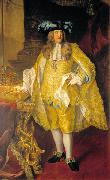 |
Johann Gottfried Auerbach -- Click Here
|
|
Johann Gottfried Auerbach (October 28, 1697 -August 5, 1753), was an Austrian painter and etcher.
Auerbach painted primarily portraits and battle genre works. Some of his works can be found at the Kunsthistorisches Museum. |
|
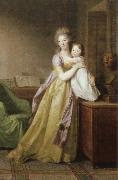 |
johann friedrich august tischbein -- Click Here
|
|
German Painter, 1750-1812. 1750 Maastricht ?C Heidelberg 1812. First he was a pupil of his father Johann Valentin Tischbein (1715-1768) in Hildburghausen, from 1768 one of his uncle Johann Heinrich Tischbein the elder (1722-1789) in Kassel.
Supported by Prince Friedrich von Waldeck he stayed in Paris from 1772 until 1777, where he studied at the academy of arts under N. B. L??pici?? (1735-1784).
Afterwards he travelled to Rome, where he got in contact with the painters A.R. Mengs (1728-1779), J.L. David (1748-1825) and Fr.H. F??ger (1751-1818) and probably also with the English style of portrait painting. 1779 he travelled to Naples.
In 1780 he returned to Arolsen via Vienna, Munich, Stuttgart and Kassel, where he worked for the Prince of Waldeck. From 1780 he was his councillor
and court painter. During this time he made several journeys e.g. to Holland and after 1785 to Weimar where he met Wieland (1785), Schlegel (1792) and other important people.
From 1795 he worked for Leopold III. of Anhalt-Dessau. 1800 he succeeded A. Fr. Oeser (1717-1799) as director of the academy of arts in Leipzig. From 1806 to 1808 he stayed in St Petersburg. He died 1812 when he visited his daughter Caroline Wilken (1783-1843) in Heidelberg
|
|
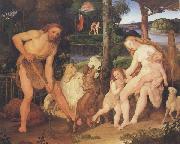 |
Johann anton ramboux -- Click Here
|
|
German, 1790 - 1866
German painter, draughtsman and museum curator. He was taught drawing by Jean-Henri Gilson (1741-1809), before he went to Paris for further training in the studio of Jacques-Louis David. In 1812 he returned to Trier, painting portraits until 1815, when he spent a year at the Akademie der Bildenden K?nste in Munich. In 1816 he went to Rome, where he was part of the Nazarene circle without becoming a member of the Lukasbr?der. Close association with these artists, notably Peter Cornelius, Carl Philipp Fohr and Julius Schnorr von Carolsfeld, had a more lasting influence on Ramboux's artistic development than his earlier studies with David |
|
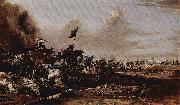 |
Johann Anton Eismann -- Click Here
|
|
(1604-1698) was an Austrian painter.
Eismann was born in Salzburg, and was active in Verona and Venice. He painted primarily harbor and some battle genre scenes. He died in Venice in 1698. |
|
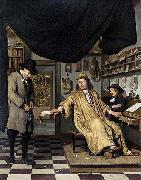 |
Job Adriaenszoon Berckheyde -- Click Here
|
|
(27 January 1630 - 10 June 1698) was a Dutch artist of the 17th century, active in Haarlem, Amsterdam, and The Hague.
Job Berckheyde was born in Haarlem and was the older brother of the painter Gerrit who he later taught to paint. He was apprenticed on 2 November 1644 to Jacob Willemszoon de Wet, and his master's influence is apparent in his first dated canvas, "Christ Preaching to the Children" (1661), one of his few biblical scenes. On 10 June 1653 he repaid a loan from the Haarlem Guild of Saint Luke. From 1656-1660 the two brothers made an extended trip along the Rhine to Germany, stopping off at Cologne, Bonn, Mannheim and finally Heidelberg, following the example of their fellow guild member Vincent van der Vinne. The brothers worked in Heidelberg for Charles I Louis, Elector Palatine (with Job producing portraits and hunting scenes, and receiving a gold chain from the Elector in reward) but were ultimately unable to adapt to court life and so returned to Haarlem, where they shared a house and perhaps a studio. He became a member of the Haarlem rederijkersgilde 'De Wijngaardranken' in 1666-1682. He is registered in Amsterdam 1682-1688, where he became a member of the Guild of St Luke there in 1685-1688.Berckheyde was buried in Haarlem. |
|
 |
Joaquin Agrasot y Juan -- Click Here
|
|
1837-1919
Spanish
Joaquin Agrasot y Juan Gallery |
|
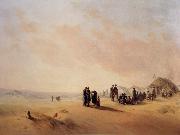 |
Jeanron Philippe Auguste -- Click Here
|
|
Boulogne-sur-Mer1809-Comborn 1877
|
|
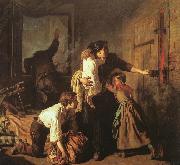 |
Jean-Pierre-Alexandre Antigna -- Click Here
|
|
painted The Fire in 1850-51
|
|
 |
Jean-Auguste-Dominique Ingres -- Click Here
|
|
1780-1867
French painter. He was the last grand champion of the French classical tradition of history painting. He was traditionally presented as the opposing force to Delacroix in the early 19th-century confrontation of Neo-classicism and Romanticism, but subsequent assessment has shown the degree to which Ingres, like Neo-classicism, is a manifestation of the Romantic spirit permeating the age. The chronology of Ingres's work is complicated by his obsessive perfectionism, which resulted in multiple versions of a subject and revisions of the original. |
|
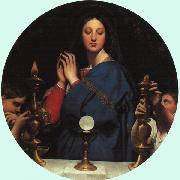 |
Jean-Auguste Dominique Ingres -- Click Here
|
|
French Neoclassical Painter, 1780-1867
was a French Neoclassical painter. Although he considered himself a painter of history in the tradition of Nicolas Poussin and Jacques-Louis David, by the end of his life it was Ingres' portraits, both painted and drawn, that were recognized as his greatest legacy.
A man profoundly respectful of the past, he assumed the role of a guardian of academic orthodoxy against the ascendant Romantic style represented by his nemesis Eug??ne Delacroix. His exemplars, he once explained, were "the great masters which flourished in that century of glorious memory when Raphael set the eternal and incontestable bounds of the sublime in art ... I am thus a conservator of good doctrine, and not an innovator." Nevertheless, modern opinion has tended to regard Ingres and the other Neoclassicists of his era as embodying the Romantic spirit of his time, while his expressive distortions of form and space make him an important precursor of modern art.. |
|
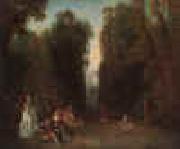 |
Jean-Antoine Watteau -- Click Here
|
|
1684-1721
Antoine Watteau Art Locations
He is best known for his invention of a new genre, the fete galante, a small easel painting in which elegant people are depicted in conversation or music-making in a secluded parkland setting (see under FETE CHAMPETRE). His particular originality lies in the generally restrained nature of the amorous exchanges of his characters, which are conveyed as much by glance as by gesture, and in his mingling of figures in contemporary dress with others in theatrical costume, thus blurring references to both time and place.
Watteau work was widely collected during his lifetime and influenced a number of other painters in the decades following his death, especially in France and England. His drawings were particularly admired. Documented facts about Watteau life are notoriously few, though several friends wrote about him after his death (see Champion). Of over two hundred paintings generally accepted as his work |
|
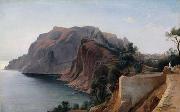 |
Jean-Achille Benouville -- Click Here
|
|
(15 July 1815, Paris - 8 February 1891, Paris) was a French landscape painter of the academic painting school, known for his Italian landscapes. François-Leon Benouville was his younger brother.
|
|
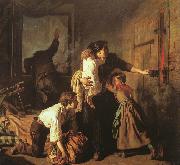 |
Jean Pierre Alexandre Antigna -- Click Here
|
|
1817-1878
French
Jean Pierre Alexandre Antigna Gallery
French painter. He was taught at the school of drawing in Orl?ans by a local painter, Fran?ois Salmon (1781-1855). On 9 October 1837 he entered the Ecole des Beaux-Arts in Paris, first in the atelier of Sebastien Norblin de la Gourdaine (1796-1884). A year later he became a pupil of Paul Delaroche, from whom he acquired his understanding of dramatic composition. |
|
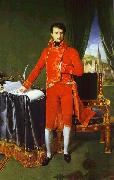 |
Jean Auguste Dominique Ingres -- Click Here
|
|
J. A. D. Ingres (1780-1867)
was born in Montauban on August 29, 1780, the son of an unsuccessful sculptor and painter. French painter. He was the last grand champion of the French classical tradition of history painting. He was traditionally presented as the opposing force to Delacroix in the early 19th-century confrontation of Neo-classicism and Romanticism, but subsequent assessment has shown the degree to which Ingres, like Neo-classicism, is a manifestation of the Romantic spirit permeating the age. The chronology of Ingres's work is complicated by his obsessive perfectionism, which resulted in multiple versions of a subject and revisions of the original. For this reason, all works cited in this article are identified by catalogue. |
|
 |
Jean antoine Watteau -- Click Here
|
|
French Rococo Era Painter, 1684-1721
He is best known for his invention of a new genre, the f?te galante, a small easel painting in which elegant people are depicted in conversation or music-making in a secluded parkland setting (see under F?TE CHAMP?TRE). His particular originality lies in the generally restrained nature of the amorous exchanges of his characters, which are conveyed as much by glance as by gesture, and in his mingling of figures in contemporary dress with others in theatrical costume |
|
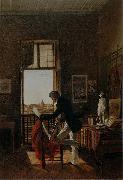 |
Jean Alaux -- Click Here
|
|
(1785 - 2 March 1864) was a French history painter and Director of the French Academy in Rome from 1846-52.
Alaux was born in Bordeaux, the son of a painter, and the second of four brothers who were all themselves painters. he received his first lessons in art from his father, but went on to formal training with Pierre Lacour, then Pierre-Narcisse Guerin. He was admitted to the École des Beaux-Arts in Paris in 1807. From 1808 he entered works for the Prix de Rome but his energies were diverted when his elder brother, Jean-Francois Alaux (1783-1858), asked him to help with a large "neorama" (a type of Panorama) he was working on. Jean eventually won the Prix de Rome's first prize in 1815, with a work entitled "Briseis weeping over the body of Patroclus", a scene inspired by The Iliad of Homer. He subsequently became a pensionnaire at the French Academy in Rome from 1816 to 1820 (later becoming its director). |
|
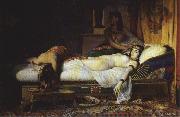 |
Jean - Andre Rixens -- Click Here
|
|
French, 1846 - 1924 |
|
 |
JANSSENS, Abraham -- Click Here
|
|
Flemish painter (b. 1575, Antwerpen, d. 1632, Antwerpen).
Flemish painter. He painted historical, religious and mythological subjects, often on a large scale, derived principally from antique sculpture and the art of Michelangelo and Raphael and, to a lesser degree, from certain contemporaries, including the Dutch late Mannerists and the Bolognese school. He was highly esteemed in Antwerp but suffered, then and subsequently, from the inevitable comparison with his contemporary and formidable rival Rubens |
|
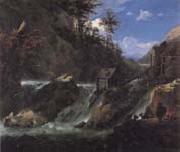 |
Jan Asselijn -- Click Here
|
|
born: Netherlands; about 1615
died: Amsterdam, Netherlands ; 1652. Italianate syle painter with big vistas small people and romantic skys |
|
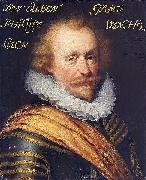 |
Jan Antonisz. van Ravesteyn -- Click Here
|
|
(1572(?) - buried June 21, 1657) was a successful painter to the Dutch court in The Hague.
Van Ravensteyn was born in The Hague. It is unknown who taught him how to paint, but he was a follower of the Delft portrait painter Michiel Jansz van Mierevelt. Van Ravesteyn is mentioned there in the city archives 1597. From 1598 until his death he lived in the Hague, where in 1598 he became a member of the Guild of St. Luke of the Hague. In 1604 he married Anna Arentsz van Berendrecht and in the same year he was mentioned as a good painter by Karel van Mander (though his earliest dated works are from 1611). In 1608 he bought a house on the Molstraat and in 1628 he moved in the Molstraat. In 1640 his wife was buried and in the same year his daughter Marie married one of his pupils, the painter Adriaen Hanneman. In 1654 he moved to the Nobelstraat next to the house of his daughter. In 1656 he left the guild with a group of dissatified painter friends and was one of the founders of the Confrerie Pictura. He was a Catholic and his name occurs often as a witness in the records of the church in the Molstraat, such as for the marriage of his daughter Agnes in 1641 with Willem van Culemborgh. His portrait was painted by Sir Anthony van Dyck and he produced Schutterstuk works. His workshop produced many portraits for the royal house of Nassau and he competed with Miereveld for several commissions.
Van Ravesteyn was in turn, the teacher of Dirck Abrahamsz., Leendert Barthouts, Johannes Harmensz. Borsman, Aelbert Dircksz. Coeppier, Pieter Craen, Jacob Dirksz. van den Enden, Fransise de Goltz, Adriaen Hanneman, Barent Jansz., Thomas Ouwater, Clement Ram, Jan Rassenbourch, Frederick Sonnius, Dirck Verlaer, Jan Pous Voet and Pauwels Willemsz.
|
|
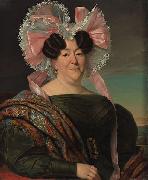 |
Jan Adam Kruseman -- Click Here
|
|
Petrus Augustus de Genestet (P.A. de Genestet) (Amsterdam, November 21, 1829 - Rozendaal, July 2, 1861) was a Dutch poet and a theologian.
Petrus Augustus de Genestet lost both of his parents at a very young age; after that he lived with his uncle, the Dutch painter Jan Adam Kruseman. He studied at the Amsterdamse Atheneum and the Seminarium der Remonstrantse Broederschap to become a preacher. He became minister in March of 1852 at the Genestetkerk (Genestetchurch) that was named after him, in Delft. In the same year he got married to Henriette Bienfait in Bloemendaal. They had two children. In 1859, he lost both his wife and oldest child died of tubercolosis, and because of his poor health he had to quit working as a minister. He moved to Amsterdam, but spent most of his summers in Bloemendaal. Two years later, in 1861, he died in Rozendaal. |
|
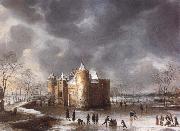 |
Jan Abrahamsz. Beerstraten -- Click Here
|
|
Flemish Baroque Era Painter, ca.1627-1666 |
|
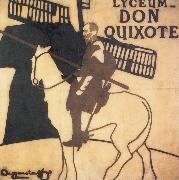 |
James Pryde and William Nicholson -- Click Here
|
|
James Pryde (1866-1941) was a Scottish artist working mainly in graphics.William Nicholson is English Painter, 1872-1949
|
|
|
|
|
|
James clarke hook,r.a -- Click Here
|
|
1819-1907
English painter. He studied with the portrait painter John Jackson and entered the Royal Academy Schools, London, in 1836, winning medals for drawing and historical painting. His Academy d?but was in 1839 with The Hard Task (untraced). In 1844 Hook was awarded a gold medal in the Houses of Parliament competition. In 1846 he won a Royal Academy travelling scholarship, enabling him to spend two years in Italy, where he was strongly influenced by the colouring of the Venetian painters. On his return his work included a series of subjects from Venetian history, including The Rescue of the Brides of Venice |
|
 |
James Augustus Suydam -- Click Here
|
|
(1819-1865) architect, lawyer, and artist; as an artist was considered one of the premier Luminism painters. He is widely known as an American landscape painter and one of the leading members of the Hudson River School.
James Augustus Suydam was descended from an old New York Dutch merchant family. He graduated from New York University (then the University of the City of New York), and began his career as a businessman but turned a significant portion of his energies to painting, studying under famed artist and portrait painter Minor C. Kellogg. At the age of thirty he was elected to the Century Association.
One of the "regulars" who gathered to paint at North Conway, New Hampshire, he exhibited Conway Meadows at the New York Athenaeum and Boston Athenaeum. He opened his studio at the noted 10th Street Studio Building, New York City, in 1858. The following year he was elected an honorary professional member in the prestigious National Academy of Design, which granted him full membership in 1861. He died suddenly in North Conway at the age of 46.
James Suydam was described by his friend, the accomplished artist Sanford Robinson Gifford as a "thoroughly educated and accomplished man. " In addition to his work as an artist, which he began only after working in law and architecture, he was widely read and well-versed in history, philosophy, and the sciences. His work as a landscape painter reflects this breadth of knowledge and reveals Suydam as a deeply spiritual individual. Using his familiarity with science, Suydam reduced nature to calm, clean, planar forms, and then distorted proportional relations so that God's creations loomed superior over the work of man.
The National Academy has most of his works such as Paradise Rocks (1865), and the Taft family's Taft Museum also holds works. The Taft also has a podcast website for this artist.
A painting of Gifford's from 1859 which Suydam, according to a report, "donated to the [National] academy in 1865," became the subject of a deaccession controversy at the Academy in late 2008.
|
|
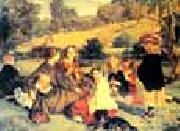 |
James Archer -- Click Here
|
|
1823-1904
British
James Archer (1823-1904) was a portrait-painter. He was born in Edinburgh, Scotland. His best-known work includes children and people in costume as its subjects becoming the first Victorian painter to do children's portraits in period costume. He studied at the Trustee's Academy in Edinburgh under Sir William Allan. At Archer painted chalk portraits, but in 1849 he exhibited his first historical picture 'The Last Supper' at the Royal Scottish Academy. His work after that mostly consisted of scenes taken from literature or legends that were popular at the time, such as Shakespeare and King Arthur. In about 1859 he began to paint a series of Arthurian subjects, including 'La Morte d'Arthur' and 'Sir Lancelot and Queen Guinevere'. James Archer died in 1904 in Haslemere in Surrey, England, survived by his son and three daughters from his marriage to Jane Clerk. |
|
 |
James Abbott Mcneill Whistler -- Click Here
|
|
American Tonalist Painter and Printmaker, 1834-1903, He was an American-born, British-based artist. Averse to sentimentality and moral allusion in painting, he was a leading proponent of the credo "art for art's sake". His famous signature for his paintings was in the shape of a stylized butterfly possessing a long stinger for a tail. |
|
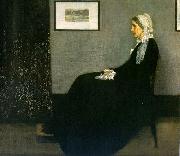 |
James Abbott McNeil Whistler -- Click Here
|
|
1834-1903
James Abbott McNeill Whistler Art Locations |
|
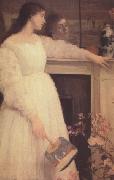 |
James Abbot McNeill Whistler -- Click Here
|
|
b Lowell MA 1834 d London 1903 |
|
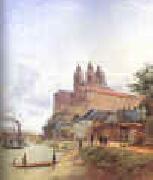 |
Jakob Alt -- Click Here
|
|
1789-1872
Austrian
Jakob Wassermann was born on March 10, 1873, in Furth, the son of a Jewish merchant. After a childhood with many restrictions, he began his career as an office clerk, in Munich and then in Freiburg. In 1898 he moved to Vienna and eventually established himself as a writer. Derivative and imitative, Wassermanns novels showed from the outset a strong dependence upon Fyodor Dostoevsky - particularly in his fondness for the psychological probing of criminals and social outcasts - as well as the influence of the master of the romantic horror and detective story, E. T. A. Hoffmann.
Wassermanns first significant work is Die Juden von Zirndorf (1897, The Jews of Zirndorf), in which his deep knowledge of his own community in F??rth and Nuremberg stands him in good stead. As in many of his other works, Wassermanns preoccupation with innocence and redemption is here interleaved with a somewhat crass depiction of depravity and superstition. Der Moloch (1902) pays tribute to the contemporary literary cult of the great city (here Vienna), seen as an all-devouring monster of sin and perversion. Caspar Hauser (1908) is probably the authors best novel; the book, based on fact, deals with the case of the mute youth who appeared one day in 1828 on the streets of Nuremberg. Resemblances to Dostoevskys The Idiot may also be noted in this tale of the rejection and contamination of innate purity by corrupt society.
After Caspar Hauser Wassermanns novels and short stories become increasingly preoccupied with bizarre and perverse anecdotes and intrigue, often initially drawn from biography or the newspapers. Das Gansemannchen (1915; The Goose Man) illuminates the problem involved in simultaneous cohabitation with two wives. Christian Wahnschaffe (1919) exploits the theme of the rich mans son who rejects the world to turn toward Buddhism. Der Fall Maurizius (1928, The Mauritius Case) is a type of detective novel made colorful by excursions into hypnosis but also weighed down by a tedious mass of psychological dissection. Like Honor?? de Balzac, whom he imitated, Wassermann introduces the same characters into different novels; thus Etzel Andergast (1931) is a sequel to The Mauritius Case, and its hero, Joseph Kerkhoven, reappears in Joseph Kerkhovens dritte Existenz (1934, Joseph Kerkhovens Third Existence).
Wassermann is a somewhat uneven and labored writer, and he cannot in any sense be considered a stylist. His novels are often marred by diffuseness and miasmic obscurity. At the same time his extensive output is of considerable historical interest and illuminates rather well the consequences of marriage between the new depth psychology and the popular novel of sensation and crime. He died on Jan. 1, 1934, in Alt-Aussee. |
|
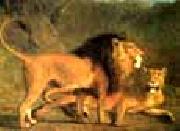 |
Jacques-Laurent Agasse -- Click Here
|
|
1767-1849
Swiss
Jacques-Laurent Agasse Galleries
(b Geneva, 24 March 1767; d London, 27 Dec 1849). English painter of Swiss birth. Born into a wealthy and politically influential Huguenot family, Agasse spent his early childhood at the country estate of Cravin, where he may have developed the interest in animals and natural history that was to guide his later career as an artist in England. Agasse trained first at the Ecole du Colibri in Geneva and subsequently in Paris under Jacques-Louis David (beginning in 1787) and possibly under Horace Vernet. His early artistic output consisted chiefly of unpretentious silhouette cut-outs in the style of Jean-Daniel Huber. At this time he also undertook a serious study of dissection and veterinary science. |
|
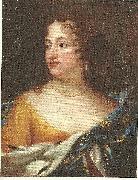 |
jacques d agar -- Click Here
|
|
Jacob d'Agar, född 1642 i Paris som Jacques d'Agar, död 1715 i Köpenhamn, var en fransk porträttmålare.
D'Agar var elev till Ferdinand Vouet. 1675 blev han ledamot av konstakademien i Paris; men efter det nantesiska ediktets upphävande 1685, i egenskap av reformert och därigenom utesluten och tvungen att gå i landsflykt, begav han sig över England till Köpenhamn, där han av Kristian V utnämndes till hovmålare. Mycket anlitad av hovet undanträngde han med sitt franska maner det dittills i Danmark härskande holländska porträttmåleriet. Ett av hans många porträtt av Kristian V finnes på Gripsholm. |
|
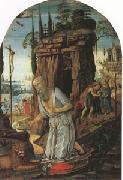 |
Jacopo di Arcangelo called jacopo del sellajo -- Click Here
|
|
Florence 1441/2-1493 |
|
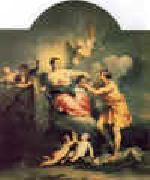 |
Jacopo Amigoni -- Click Here
|
|
1685-1752
Italian Jacopo Amigoni Galleries
He was born in Naples or Venice. Amigoni initially painted both mythological and religious scenes; but as the panoply of his patrons expanded northward, he began producing many parlour works depicting gods in sensuous languor or games. His style influenced Giuseppe Nogari. Among his pupils were Charles Joseph Flipart, Michelangelo Morlaiter, Pietro Antonio Novelli, Joseph Wagner, and Antonio Zucchi.
Starting in 1717, he is documented as working in Bavaria in the Castle of Nymphenburg (1719); in the castle of Schleissheim (1725-1729); and in the Benedictine abbey of Ottobeuren. He returned to Venice in 1726. His Arraignment of Paris hangs in the Villa Pisani at Stra. From 1730 to 1739 he worked in England, in Pown House, Moor Park and in the Theatre of Covent Garden. From there, he helped convince Canaletto to travel to England by telling him of the ample patronage available.
From his travel to Paris in 1736, he met the celebrated castrato named Farinelli. Later in Madrid, he was to paint a self-portrait with the singer and entourage. He also encountered the painting of François Lemoine and Boucher.
In 1739 he returned to Italy, perhaps to Naples and surely to Montecassino, in whose Abbey existed two canvases (destroyed during World War II). Until 1747, he travelled to Venice to paint for Sigismund Streit, for the Casa Savoia and other buildings of the city. In 1747 he left Italy and established himself in Madrid. There he became court painter to Ferdinand VI of Spain and director of the Royal Academy of Saint Fernando. He died in Madrid. |
|
|
|
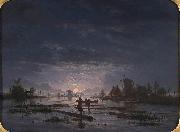 |
Jacob Abels -- Click Here
|
|
(1803 - 1866) was a Dutch painter.
He was born in Amsterdam in 1803, and was instructed in art by Jan van Ravenswaay, the animal painter. In 1826 he visited Germany, and on his return settled at the Hague. He distinguished himself especially in painting moonlight landscapes. The Museum at Haarlem has works by him. Abels died at Abcoude in 1866.
|
|
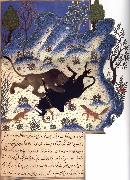 |
Jackals Kalila and Dimna -- Click Here
|
|
the period of 1465-1535
|
|
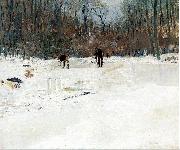 |
J. Alden Weir -- Click Here
|
|
(August 30, 1852 - December 8, 1919) was an American impressionist painter and member of the Cos Cob Art Colony near Greenwich, Connecticut. Weir was also one of the founding members of "The Ten", a loosely-allied group of American artists dissatisfied with professional art organizations, who banded together in 1898 to exhibit their works as a stylistically unified group.
|
|
 |
J B Armand Guillaumin -- Click Here
|
|
1841-1927
Born Jean-Baptiste Armand Guillaumin in Paris, France, he worked at his uncle's lingerie shop while attending evening drawing lessons. He also worked for a French government railway before studying at the Academie Suisse in 1861. There, he met Paul C??zanne and Camille Pissarro with whom maintained lifelong friendships. While he never achieved the stature of these two, his influence on their work was significant. C??zanne attempted his first etching based on Guillaumin paintings of barges on the River Seine.
Guillaumin exhibited at the Salon des Refus??s in 1863 and later became a friend of Vincent van Gogh whose brother, Theo sold some of his works.
Noted for his intense colors, major museums around the world display Guillaumin's art. He is best remembered for his landscapes of Paris, the Creuse departement, and the area around Les Adrets-de-l'Esterel near the Mediterraneran coast in the Provence-Alpes-Cote d'Azur region of France.
Armand Guillaumin died in 1927 in Orly, Val-de-Marne just south of Paris. |
|
|
|
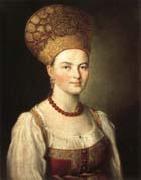 |
Ivan Argunov -- Click Here
|
|
Russian Rococo Era Painter , 1727/1729-1802
Russian painter and teacher. He came from a family of serfs, belonging to the Counts Sheremetev, that produced several painters and architects. In about 1746-7 he was a pupil of Georg Christoph Grooth (1716-49), who painted portraits of the Sheremetev family. With Grooth, Argunov worked on the decoration of the court church at Tsarskoye Selo (now Pushkin). A full-length icon of St John of Damascus (1749; Pushkin, Pal.-Mus.), in Rococo style, is distinguished by its secular, decorative character. The Dying Cleopatra (1750; Moscow, Tret'yakov Gal.) is typical of Rococo decorative painting of the mid-18th century, with its striking combination of light, soft tones. Argunov subsequently painted in a quite different style, mainly producing portraits, of which about 60 are known. Among the first of these are pendant portraits of Ivan Lobanov-Rostovsky and his wife (1750 and 1754; St Petersburg, Rus. Mus.), in which the sitters are idealized, as in ceremonial court portraits. |
|
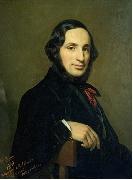 |
Ivan Aivazovsky -- Click Here
|
|
July 29, 1817 C May 5, 1900) was a Russian painter of Armenian descent, most famous for his seascapes, which constitute more than half of his paintings.Aivazovsky was born in the town of Feodosiya, Crimea, to a poor Armenian family. His parents family name was Aivazian. Some of artist's paintings bear a signature, in Armenian letters, "Hovhannes Aivazian" (Յովհաննէս Այվազեան). His talent as an artist earned him sponsorship and entry to the Simferopol gymnasium ??1 and later the St.Petersburg Academy of Arts, from which he graduated with the gold medal. Earning awards for his early landscapes and seascapes, he went on to paint a series of portraits of Crimean coastal towns before traveling throughout Europe. In later life, his paintings of naval scenes earned him a longstanding commission from the Russian Navy.
In 1845, Aivazovsky went to Istanbul upon the invitation of Sultan Abdelmecid, a city he was to travel to eight times between 1845-1890. |
|
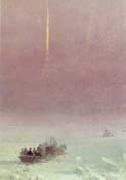 |
Ivan Aivazovski -- Click Here
|
|
Russian artist .1817-1900
|
|
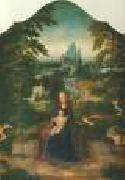 |
ISENBRANT, Adriaen -- Click Here
|
|
Flemish Northern Renaissance Painter, ca.1500-1551 |
|
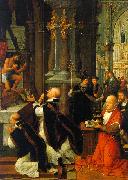 |
Isenbrandt, Adriaen -- Click Here
|
|
Flemish Northern Renaissance Painter, ca.1500-1551
South Netherlandish painter. He became a master in the Bruges Guild of St Luke in 1510, at which time the records specify that he was a 'stranger' and childless. Shortly afterwards he married Maria Grandeel, who bore him one child (d 1512). After his wife's death in 1537, Isenbrandt married Clementine de Haerne, with whom he had three daughters. One further daughter was born through an extra-marital relationship with the innkeeper Katelijne van Brandenburch. According to contemporary sources, Isenbrandt was famous and well-to-do. He held important posts in the Bruges Guild of Sculptors and Saddlemakers, serving as deacon nine times between 1518 and 1538 and as governor twice (1526-7 and 1537-8). |
|
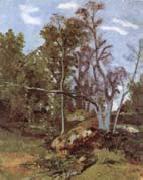 |
Ion Andreescu -- Click Here
|
|
n. 15 februarie 1850, Bucuresti . 22 octombrie 1882, Bucuresti
He was born in Bucharest into a merchant family. In 1869 he entered Theodor Aman Fine Arts School.
By 1872 he was an instructor of drawing and calligraphy at the Bishop School in Buzau. In 1873 he left the Bishop School for the Tudor Vladimirescu Communal Secondary School, also in Buzau. Then, in 1875 he left the Communal Secondary School for Buzau Craftsmanship School.
Influenced by Nicolae Grigorescu, he left Romania for Paris to further his education. In Paris, he began painting at Barbizon. His work was exhibited with the works of better known painters such as Manet, Monet and Renoir.
In 1881 he returned to Romania, ill with tuberculosis. His death followed shortly in 1882. |
|
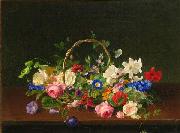 |
Horace Aumont -- Click Here
|
|
painted Flowers in 1860 |
|
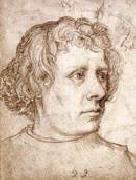 |
HOLBEIN, Ambrosius -- Click Here
|
|
German Northern Renaissance Painter, 1494-ca.1519
Painter, draughtsman and designer of woodcuts, son of Hans Holbein. In the drawing of Ambrosius and Hans Holbein the Younger (1511; Berlin, Kupferstichkab.) by their father, Hans's age is given as 14, and although that of Ambrosius cannot be read clearly, he appears to have been the elder brother. In 1514 he was probably working near the Bodensee, and a Virgin and Child (Basle, Kstmus.), with the coat of arms of Johann von Botzheim, Canon of Konstanz Cathedral (c. 1480-1535), appears to be his work. In 1515 he was working as a journeyman to the painter Thomas Schmid (c. 1480-c. 1550-60) on the decoration of the abbot's Festsaal in the Benedictine St Georgkloster at Stein-am-Rhein, which included allegorical figures of women, one of which, Death with a Female Lute-player (in situ), is signed AH. Also in 1515 he joined his brother Hans in Basle, where together they decorated with marginal drawings (1515-16) the copy of Erasmus's Praise of Folly (Basle, Kstmus.) belonging to the schoolmaster Myconius (Oswald Geissh?sler; d 1552); the distinction between the hands of the two brothers can be made only on stylistic grounds. They also painted a school sign for Myconius, each apparently working on a different side. On 25 July 1516 Ambrosius was recorded staying in the house of the painter Hans Herbst, in whose workshop he may have been employed. On 14 February 1517 he was enrolled in the Basle painters' guild, and on 5 June 1518 he became a citizen of the city. Numerous woodcut designs executed for Basle printers from 1517 onwards and signed with Ambrosius Holbein's initials survive, most of which are set in architectural frameworks inspired by the Italian Renaissance, |
|
 |
Hoca Ali Riza -- Click Here
|
|
(1858 - 1939) was a Turkish painter.
Portrait of Hoca Ali Riza
Kizkulesi (Leander Tower), painting by Hoca Ali RizaBorn in Uskudar, Istanbul. Painted many landscapes of Istanbul and especially Uskudar. Attended Kuleli Military High School and then the Military Academy. There he studied under Osman Nuri Pasha, Seleyman Seyyid and Monsieur Gues, and graduated in 1884. From 1909 to 1912 he served as President of the Society of Ottoman Painters.
|
|
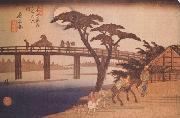 |
Hiroshige, Ando -- Click Here
|
|
Japanese Ukiyo-e Printmaker, 1797-1858
Japanese painter and printmaker. He was one of the greatest and most prolific masters of the full-colour landscape print and one of the last great ukiyoe ('pictures of the floating world') print designers |
|
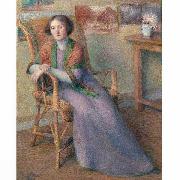 |
Hippolyte Petitjean -- Click Here
|
|
Hippolyte Petitjean (1854 - 1929)
|
|
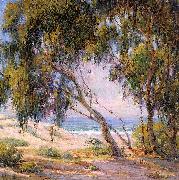 |
Hills, Anna Althea -- Click Here
|
|
American Painter, 1882-1930 |
|
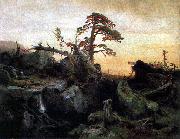 |
Hermann August Cappelen -- Click Here
|
|
(1 May 1827 - 8 March 1852) was a Norwegian painter. Cappelen was best known for his melancholic, dramatic and romantic landscape compositions.
Hermann August Cappelen was born in Skien, Norway. He was the son of Diderik von Cappelen (1795-1866) and Margaret Noble Severine Henriette Løvenskiold (1796-1866). Both the Løvenskiold and Cappelen families were prominent Norwegian family of merchants, land owners, civil servants and politicians. His family were the owners of prominent iron works and various other properties. His grandfather, Diderik von Cappelen (1761-1828), was member of the Norwegian Constituent Assembly at Eidsvoll in 1814.
He grew up at Holden, a manor in Ulefoss in the Grenland district of the county of Telemark. After school graduation in Skien in 1845, he went to Christiania to take another exam at the University of Oslo. He subsequently went to Dusseldorf, where he studied with Hans Gude. Cappelen was a student at Kunstakademie Dusseldorf under Johann Wilhelm Schirmer in landscape painting class (1846-1850). |
|
 |
Herman af Sillen -- Click Here
|
|
painted Svenskt orlogsfartyg in 1901 |
|
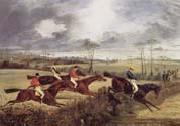 |
Henry Thomas Alken -- Click Here
|
|
1785-1851, Painter and engraver, son of Samuel Alken. He worked in London and the provinces and was prolific in a variety of media while unadventurous in his range of subject-matter. Early instruction by the miniature painter J. T. Beaumont (1774-1851) helped to give a certain graphic precision |
|
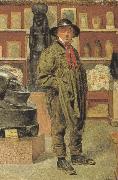 |
Henry stacy marks,R.A. -- Click Here
|
|
1829-1898
English painter. He studied with J. M. Leigh (1808-60) from 1847 and in January 1851 enrolled at the Royal Academy Schools. In 1852 Marks and P. H. Calderon spent five months studying in Paris under Fran?ois-Edouard Picot and at the Ecole des Beaux-Arts. The next year he made his d?but at the Royal Academy Summer Exhibition, where he exhibited annually until 1897. He was elected ARA in 1871 and RA in 1878. |
|
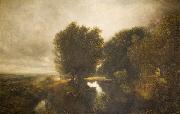 |
Henry Mark Anthony -- Click Here
|
|
(4 August 1817 - 1 December 1886) was an English landscape artist, often favourably compared to John Constable by critics. He exhibited at many major art institutions and travelled widely, being credited with introducing the en plein air style of painting to Britain.
|
|
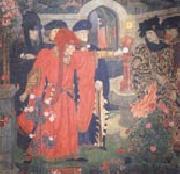 |
Henry Arthur Payne -- Click Here
|
|
British Architect , 1868-1940 |
|
|
|
|
|
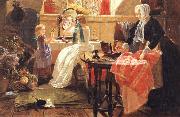 |
Henrietta Mary Ada Ward -- Click Here
|
|
Historical genre painter.1852-1924
|
|
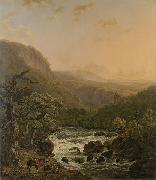 |
Henri van Assche -- Click Here
|
|
born at Brussels in 1774, showed from his earliest years a predilection for painting, and received from his father, who was a distinguished amateur artist, the first principles of design and perspective. He was afterwards placed with Deroy of Brussels, from whom he received further instructions in painting. Journeys in Switzerland and Italy contributed to develop his talent as a landscape painter. His great partiality for representing waterfalls, mountain streams, and mills gained for him the name of 'The Painter of Waterfalls.' Several pictures by him may be seen in public and private collections of Brussels, Ghent, Lille, and Haarlem, some of which are enriched with figures and animals by Ommeganck. He died at Brussels in 1841.
|
|
|
|
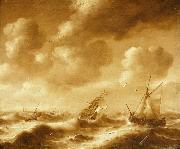 |
Hendrick van Anthonissen -- Click Here
|
|
(29 May 1605, Amsterdam - 12 November 1656, Amsterdam) was a Dutch marine painter.
Van Anthonissen was the son of Aert Anthonisz (a.k.a. Aart van Antum) and painted in the style of his brother-in-law and teacher Jan Porcellis and of Jan van Goyen. He is the author of sea paintings in the Hermitage, St. Petersburg and the Prague Gallery, which through their signatures have been ascribed to a mythical Hendrik van Antem. In the 1630's he lived in The Hague, Leiden, and Leiderdorp, but from 1642 he was back in Amsterdam. He is known for beach scenes and seascapes in the manner of Jan Porcellis, sometimes in grisaille. He was the father of the marine painter Arnoldus van Anthonissen.
|
|
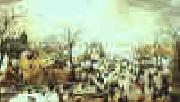 |
Hendrick Avercamp -- Click Here
|
|
1585-1634
Dutch
Hendrick Avercamp Galleries
Hendrick Avercamp (bapt. January 27, 1585, Amsterdam - buried May 15, 1634, Kampen (Overijssel)) was a Dutch painter.
Avercamp studied in Amsterdam with the Danish-born portrait painter Pieter Isaacks (1569-1625), and perhaps also with David Vinckbooms. In 1608 he moved from Amsterdam to Kampen in the province of Overijssel. Avercamp was deaf and was known as "de Stomme van Kampen" (the mute of Kampen).
As one of the first landscape painters of the 17th-century Dutch school, he specialized in painting the Netherlands in winter. Avercamp's paintings are colorful and lively, with carefully crafted images of the people in the landscape.
Avercamp's work enjoyed great popularity and he sold his drawings, many of which were tinted with water-color, as finished pictures to be pasted into the albums of collectors. Queen Elizabeth II has an outstanding collection of his works at Windsor Castle, England. |
|
|
|
|
|
Helen Allingham,R,W.S -- Click Here
|
|
1848-1926
Studies of Flowers
Studies of Flowers .was a well-known watercolour painter and illustrator of the Victorian era. Helen Mary Elizabeth Paterson was born in Swadlincote in Derbyshire,[1] England. Her sister and her father, a doctor, died of diphtheria in 1862, and the rest of the family went to live in Birmingham. In 1867 she went to study art at the "Female School of Art", a section of what became the Royal College of Art in London, and became an illustrator of children's books. She was a great friend of Kate Greenaway. On 22 August 1874, she married William Allingham, who was almost twice her age. At the time, she was employed in illustrating some of the novels of Thomas Hardy, and they were attracted to one another when they met. Helen Allingham illustrated several books, including Six to sixteen: a story for girls (1876), Happy England (1903) and The homes of Tennyson (1905), written with her brother Arthur Paterson. After her marriage to Allingham, she became a watercolour painter, and she was the first woman to become a full member of the Royal Watercolour Society. As well as landscapes, she completed several portraits, including one of Thomas Carlyle. |
|
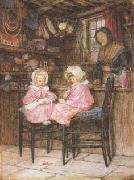 |
Helel Allingham,RWS -- Click Here
|
|
1848-1926
was a well-known watercolour painter and illustrator of the Victorian era. Helen Mary Elizabeth Paterson was born in Swadlincote in Derbyshire,[1] England. Her sister and her father, a doctor, died of diphtheria in 1862, and the rest of the family went to live in Birmingham. In 1867 she went to study art at the "Female School of Art", a section of what became the Royal College of Art in London, and became an illustrator of children's books. She was a great friend of Kate Greenaway. On 22 August 1874, she married William Allingham, who was almost twice her age. At the time, she was employed in illustrating some of the novels of Thomas Hardy, and they were attracted to one another when they met. Helen Allingham illustrated several books, including Six to sixteen: a story for girls (1876), Happy England (1903) and The homes of Tennyson (1905), written with her brother Arthur Paterson. After her marriage to Allingham, she became a watercolour painter, and she was the first woman to become a full member of the Royal Watercolour Society. |
|
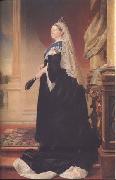 |
Heinrich von Angeli -- Click Here
|
|
1840 - 1925
Austrian painter. In 1853 he moved to Vienna to live with his uncle, who was a collector and a friend of the painters Friedrich von Amerling and Mathias Ranftl (1805-54). Angeli's early Self-portrait reflects the precocious maturity of his style, and in 1854 he enrolled at the Akademie der Bildenden K?nste in Vienna. In 1856, on the advice of Amerling, he went to study under Emanuel Gottlieb Leutze in D?sseldorf, where he executed one of his most significant history paintings, Mary Stuart Reading her Death Warrant (1857). In 1859 he moved to Munich, where he worked independently and was encouraged by Karl Theodor von Piloty, producing the history paintings Ludwig XI and Franz de Paula (1859) and Antony and Cleopatra for Ludwig I of Bavaria. In 1862 he again settled in Vienna, where he enjoyed increasing success. The life-size portrait of Baronin Seidler and the genre painting Avengers of Honour (1869), both exhibited at the Weltausstellung in Vienna in 1873, secured his reputation. After brief stays in Paris and Berlin (c. 1866), he went in 1871 to Italy, where he painted numerous portraits and the genre work Absolution Denied. His final genre paintings, Youthful Love (sold London, Sotheby's, 3 Oct 1980) and Calabrian Shepherd Couple, also date from this year. Henceforth he devoted himself entirely to portrait painting, receiving important commissions from such aristocratic circles as the Kinsky and Auersperg families (e.g. Graf Anton Alexander Auersperg, 1876; Vienna, Pr?sidium des Nationalrates). Whereas his early portraits were influenced by Amerling, Anton Einsle and 17th-century Dutch art, from the 1870s he developed his own elegant and restrained style. This helped him to obtain commissions at the courts of Vienna, St Petersburg and London |
|
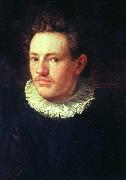 |
Hans von Aachen -- Click Here
|
|
was a German mannerist painter.
His name is derived from the birth place of his father, Aachen in Germany. Other variations of the name include Johann von - and - von Achen and various concisions like Janachen, Fanachen, Abak, Jean Dac, Aquano, van Aken etc.
Hans von Aachen began painting in Germany as a pupil of the Flemish master E. Jerrigh. He then moved to Italy in 1574 to study further. He toured Rome and Florence, but eventually settled in Venice. He initially became a pupil of Kaspar Rems, but soon decided to develop his own mannerist technique, by studying Tintoretto and Michelangelo's followers. However, during all of his life he was influenced by the style of Bartholomeus Spranger and Hendrick Goltzius who dominated the art scene in Germany at the time.
He returned to Germany in 1588 where he became well known as a painter of portraits for noble houses. He painted several works for Duke William V of Bavaria. He married Regina, the daughter of the composer Orlando di Lasso in Munich. In Munich he came into contact with the Imperial Court in Prague. In 1592 he was appointed official painter of Rudolph II, Holy Roman Emperor. However, Von Aachen only moved to Prague in 1601, where he stayed painting commissions from Emperor Rudolph II, and later from Matthias I.
Amongst van Aachens pupils were Peter Isaak and Joseph Heinz. His works have been copied by Wolfgang Kilian, Dominicus Custos and Jan Sadeler.
|
|
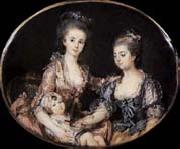 |
HALL, Peter Adolf -- Click Here
|
|
1739-1793
Swedish painter and collector. In 1753 he attended Uppsala Universitet to study medicine and natural history. In 1755 he went on a study trip abroad, led by his drawing-master Lars Brisman. While in Germany (1756-9) he studied miniature painting with Eichhardt in Berlin and with Karl Friedrich Wilhelm Richard (1725-70) in Hamburg. After this trip, he decided to become a professional portrait painter, and in 1759 he enrolled at the Kungliga Akademi for de Fria Konsterna in Stockholm, studying drawing with the French sculptor Pierre-Hubert Larchaveque (1721-78) and painting with Gustaf Lundberg. He attracted the attention of C. F. Adelcrantz, who in 1766 gained for him a commission for the pastel portrait of Princes Karl and Fredrik Adolf. In that year he also executed a miniature portrait of Crown Prince Gustav on the occasion of his engagement to Princess Sophia Magdalena of Denmark. Also in 1766 he received a royal travel grant to study in Paris, where he developed a completely new technique of miniature painting using sweeping brushwork and a clear and fresh range of colour that allowed for lively characterization. He made exquisite detailed studies of the backgrounds of his paintings, as well as his sitters costumes and their attributes and accessories. His new technique involved applying gouache to the ivory in a manner that allowed the ivory to show through, a method that was particularly successful in depicting drapery. The smooth surface of the ivory also allowed freer brushwork associated with full-scale portraits. |
|
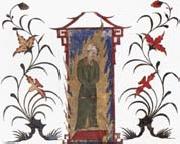 |
Hafiz i Abru -- Click Here
|
|
the period of 1465-1535
|
|
|
|
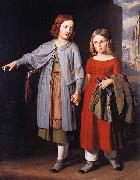 |
Gustav Adolph Hennig -- Click Here
|
|
Gustav Adolph Hennig (1797-1869)Professions: Historical-scenes painter; Porträtmaler; Miniature painter; Etcher; Lithographer. |
|
|
|
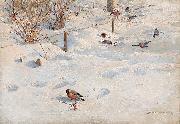 |
Gunnar aberg -- Click Here
|
|
Gunnar Berg (21 May 1863 -23 December 1893) was a Norwegian painter, known for his paintings of his native Lofoten. He principally painted memorable scenes of the everyday life of the local fishermen. |
|
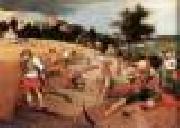 |
GRIMMER, Abel -- Click Here
|
|
Flemish Baroque Era Painter, ca.1570-C.1619
Son of Jacob Grimmer. He married Catharina Lescornet on 29 September 1591 and in 1592 became a master in the Antwerp Guild of St Luke. He is principally known for his numerous small paintings of country scenes, sometimes with a biblical theme, which often form part of a series of the Four Seasons or the Months of the Year. Some of these paintings were inspired by or even copied from prints by Pieter Bruegel I and Hans Bol, both of whose work strongly influenced Abel, even more so than did the example of his father's work, which was also an important source of inspiration. Abel's series of the Twelve Months (1592; Montfaucon-en-Velay, Haute-Loire, Chapelle Notre-Dame) are exact copies of Adriaen Collaert's prints after Hans Bol (Hollstein: Dut. & Flem., iv, nos 523-34), published by Hans van Luyck ( fl c. 1580-85) in 1585. Spring and Summer (Antwerp, Kon. Mus. S. Kst.) are almost exact copies of two prints by Pieter van der Heyden |
|
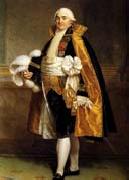 |
GREGORIUS, Albert -- Click Here
|
|
Belgian painter
b. 1774, Bruges, d. 1853, Bruges |
|
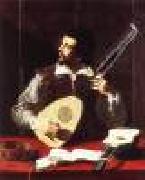 |
GRAMATICA, Antiveduto -- Click Here
|
|
Italian Baroque Era Painter, 1571-1626
Italian painter. He was from a Sienese family. According to Baglione, his parents were journeying from Siena to Rome when his mother went into labour and gave birth to him at an inn, an inconvenience that had been foreseen ('antiveduto') by his father and led to his unusual name. For a brief period he was a pupil of Giandomenico Angelini ( fl 1550-1600), under whom he painted small-scale works, mainly on copper. His prolific production of devotional paintings, portraits and copies of portraits won him swift success; in 1593 he became a member of the Accademia di S Luca and in 1604 of the Congregazione dei Virtuosi. His early portraits have not been identified; they included highly popular copies of a series of Famous Men then at the Villa Medici, works that Caravaggio probably also copied when he worked for some months in his studio on his arrival in Rome in 1592 |
|
|
|
|
| | |
|
|
|
|